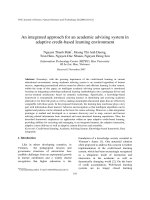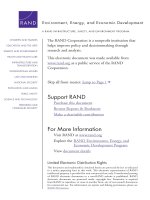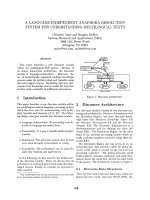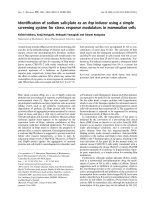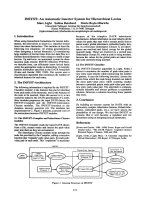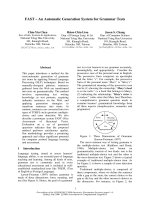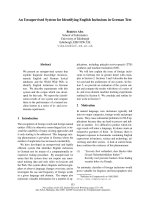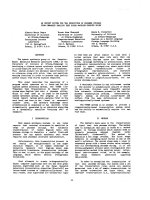An operating system for augmented reality ubiquitous computing environments
Bạn đang xem bản rút gọn của tài liệu. Xem và tải ngay bản đầy đủ của tài liệu tại đây (2.87 MB, 160 trang )
AN OPERATING SYSTEM FOR AUGMENTED REALITY UBIQUITOUS
COMPUTING ENVIRONMENTS
YEW WEIWEN, ANDREW
(B.Eng. (Hons.), NUS)
A THESIS SUBMITTED
FOR THE DEGREE OF DOCTOR OF PHILOSOPHY
DEPARTMENT OF MECHANICAL ENGINEERING
NATIONAL UNIVERSITY OF SINGAPORE
2014
Declaration
I hereby declare that this thesis is my original work and it has been written by
me in its entirety. I have duly acknowledged all the sources of information
which have been used in the thesis.
This thesis has also not been submitted for any degree in any university
previously.
_______________________________
Yew Weiwen, Andrew
18 November 2014
i
Acknowledgements
I would like to express my sincerest gratitude to my thesis supervisors, Assoc.
Prof Ong Soh Khim and Prof. Andrew Nee Yeh Ching, for granting me the
opportunity and support to carry out this research. Their faith and guidance
have been invaluable. Every endeavor they have made in making our
laboratory a happy, clean and conducive environment for research, as well as
their efforts in looking after my welfare, is greatly appreciated.
Sincere thanks also go to my fellow researchers in the Augmented Reality and
Assistive Technology Lab past and present for their advice and friendship. I
would like to make special mention of Dr. Shen Yan and Dr. Zhang Jie who
helped me with a great many matters concerning my academic duties and
settling into the laboratory, and of Dr. Fang Hongchao who has been a
constant source of companionship, encouragement, and technical help. I would
also like to thank the FYP students whom I have mentored who provided
valuable assistance with this work.
Finally, I wish to thank my family for taking an active interest in my research
work, and sometimes giving me wild ideas to ponder, and my parents for
sacrificing so much in order for me to pursue this dream.
ii
Table of Contents
Acknowledgements
…………………………………………
i
Table of Contents
………………………………………………
ii
List of Figures
………………………………………………….
vi
List of Tables
…………………………………………………
viii
List of Abbreviations
…………………………………………
ix
Summary
………………………………………………………
xi
Chapter 1. Introduction
………………………………………
1
1.1
Ubiquitous Computing
…………………………
1
1.2
Augmented Reality
……………………………….
2
1.3
Research Objectives and Scope
…………………
4
1.4
Organization of the Thesis
………………………
7
Chapter 2. Literature Survey
…………………………………
8
2.1
Ubiquitous Computing Issues
…………………….
8
2.1.1
Heterogeneity and Spontaneous Interoperation
…
8
2.1.2
Invisibility
……………………………………
9
2.1.3
Transparent User Interaction
………………….
10
2.1.4
Context Awareness and Context Management
…
13
2.2
Augmented Reality Issues
………………………
13
2.2.1
Tracking
……………………………………….
13
2.2.2
Display and Interaction Devices
……………
17
2.3
Ubiquitous Augmented Reality Frameworks
……
19
2.3.1
High-level Frameworks
………………………
19
2.3.2
Component-based Frameworks
………………
20
iii
2.3.3
Standards-based Frameworks
……………….
24
2.4
Summary
………………………………………….
26
Chapter 3. Design of the SmARtWorld Framework
…………
28
3.1
Requirements
……………………………………
28
3.2
Overall Architecture
……………………………
29
3.3
Smart Objects
……………………………………
31
3.3.1
Smart Object Architecture
…………………….
31
3.3.2
Virtual User Interface
…………………………
33
3.4
Communications Protocol
…………………………
37
3.4.1
Messaging
……………………………………
37
3.4.2
Addressing and Routing
………………………
40
3.5
Summary
………………………………………….
46
Chapter 4. Implementation of a SmARtWorld Environment
…
48
4.1
Basic Smart Object
……………………………….
48
4.1.1
Fundamental Layer
…………………………
49
4.1.2
Functionality & Data Interface Layer
……….
50
4.1.3
Functionality & Data Access Layer
…………
51
4.2
Primary Server
……………………………………
53
4.3
Landmark Server and Landmark Objects
………
55
4.4
Object Tracker
………………………………….
58
4.5
Summary
………………………………………….
59
Chapter 5. User Interaction and Display Devices
…………….
61
5.1
Wearable System
…………………………………
61
5.1.1
Pose Tracking
………………………………
62
iv
5.1.2
Rendering Virtual User Interfaces
……………
65
5.1.3
Bare Hand Interaction
………………………
70
5.1.4
Occlusion of Virtual Elements by the Hand
…
75
5.2
Tablet and Smartphone
……………………………
76
5.3
Device-less Interaction
……………………………
78
5.3.1
Sensors on a Wireless Sensor Network
……….
79
5.3.2
Gaze Tracking
………………………………
80
5.3.3
Context Recognition
………………………….
82
5.4
Summary
………………………………………….
85
Chapter 6. Smart Object Representation
………………………
87
6.1
Real and Virtual Objects
………………………….
87
6.2
Realistic Rendering
……………………………….
88
6.3
Physical Simulation
……………………………….
90
6.4
Sound Response
………………………………….
92
6.4.1
Sound Source
………………………………….
92
6.4.2
Sound Renderer
……………………………….
95
6.5
Summary
…………………………………………
96
Chapter 7. Manufacturing Applications
………………
98
7.1
Manufacturing Job Shop
………………………
99
7.1.1
Smart CAD Object
…………………………
99
7.1.2
Smart Machining Object
……………………
101
7.2
Manufacturing Grid
……………………………
104
7.2.1
Web Server
…………………………………
105
7.2.2
Cloud Gateway
………………………………
107
v
7.3
Visual Programming
……………………………
109
7.3.1
Robot Task Programming
…………………
110
7.3.2
Programming Robot Safety Procedures
…….
113
Chapter 8. Conclusion
………………………………………….
118
8.1
Achievement of Objectives
………………………
118
8.2
Contributions
……………………………………
122
8.3
Recommendations
……………………………….
126
Publications from this Research
………………………………
128
References
………………………………………………………
129
vi
List of Figures
2-1
Coordinate transformations from virtual object to AR
………
14
3-1
Architecture of a smart object
…………………………………
31
3-2
Network connections in a SmARtWorld environment
……….
40
3-3
Propagation of smart object existence
………………………
43
3-4
(a) Addresses used by hubs for objects hosted directly. (b)
Addresses used by hubs for the same objects which are
hosted directly or indirectly. (c) Addresses used by one of
the objects to send messages to the other objects. (d) Routing
of a message over multiple hubs.
…
44
4-1
Architecture of a UAR environment
…………………………
48
4-2
Creation of a virtual user interface
……………………………
52
4-3
Virtual user interface definitions for the basic smart object
…
53
4-4
Database of smart object information in the primary server
…
55
4-5
Virtual user interface of a landmark object
…………………
57
5-1
A wearable system
…………………………………………….
61
5-2
Flowchart of the wearable system program execution
………
62
5-3
Occlusion of virtual objects by real objects
…………………
68
5-4
Texture-based font rendering
…………………………………
68
5-5
Signed distance field representation of fonts
…………………
69
5-6
Zoom-invariant font quality and font effects
…………………
69
5-7
(a) Depth of a convexity defect indicates presence of fingers,
(b) fingertip is the furthest point from the centroid of the
hand
…
71
5-8
The detection stages of different gestures
……………………
72
5-9
Bare hand interaction with virtual user interface elements
……
74
5-10
Occlusion of virtual objects by the user’s hand
………………
75
5-11
Flowchart of the Android system program execution
………….
77
vii
5-12
Touch-screen interaction with virtual user interface elements
…
78
5-13
Setup for object interaction using gaze tracking
………………
81
5-14
Placement of smart objects for gaze tracker interaction
………
82
5-15
Training an HMM-based context recognition object using a
smartphone
…
85
6-1
A virtual weather sensor object
………………………………
88
6-2
Shadows cast by virtual objects due to real light
sources in the environment
………………
90
6-3
A virtual object reflecting the real environment
………………
90
6-4
Sound waves generated by two smart objects with
different stiffness and natural frequency
……………
95
7-1
(Top) Smart CAD object creation tool, (bottom)
SolidWorks part document converted into a smart
CAD object.
……………
100
7-2
An interactive smart CAD object
………………………………
101
7-3
Smart machining object: (a) Maintenance interface,
(b) CAM interface, (c) Dragging a smart CAD object
to the CAM interface, and (d) Smart CAD object
loaded in the CAM interface
………
103
7-4
Architecture of manufacturing grid of smart objects
…………
104
7-5
Smart machining object from a remote SmARtWorld
environment
………
107
7-6
Flow diagram of a program that stops a factory robot
arm when a worker approaches it.
………
115
viii
List of Tables
3-1
Basic data and commands of a smart object
……………………
33
3-2
List of XML tags for interactive elements of a virtual
user interface
………
35
3-3
List of standard commands and their parameters
………………
39
4-1
Command and RPC handling procedures for a basic
smart object
………
51
4-2
RPCs in a landmark server object
………………………………
56
4-3
RPCs in a landmark object
……………………………………
57
7-1
Smart objects of a pick-and-place robot workspace
…………….
111
7-2
Smart objects for flow-based programming in a
SmARtWorld environment
……
114
ix
List of Abbreviations
2D - Two-dimensional
3D - Three-dimensional
AP - Access point
AR - Augmented reality
ARAF - Augmented Reality Application Framework
ARML - Augmented Reality Markup Language
ASCII - American Standard Code for Information Interchange
CAD - Computer-aided design
CAM - Computer-aided manufacturing
CNC - Computer numerical control
CV - Computer vision
FBP - Flow-based programming
GML - Geography Markup Language
GPS - Global Position System
GUI - Graphical user interface
HMD - Head-mounted display
HMM - Hidden Markov model
HTML - HyperText Markup Language
IP - Internet Protocol
KHARMA - KML/HTML Augmented Reality Mobile Architecture
KML - Keyhole Markup Language
LAN - Local area network
LED - Light-emitting diode
MGrid - Manufacturing grid
x
MRU - Most recently used
ODE - Open Dynamics Engine
OOP - Object-oriented programming
RF - Radio frequency
RPC - Remote procedure call
SDK - Software development kit
SNAP - Synapse Network Application Protocol
TCP - Transmission Control Protocol
TUI - Tangible user interface
UAR - Ubiquitous augmented reality
UbiComp - Ubiquitous computing
UDP - User Datagram Protocol
URI - Uniform resource identifier
URL - Uniform resource locator
VR - Virtual reality
WSN - Wireless sensor network
XML - Extensible Markup Language
xi
Summary
The aim of ubiquitous computing is to shift computing tasks from the
traditional desktops to the user’s physical environment. Today, the
manifestation of this vision can be seen in the proliferation of tablet devices
and smartphones that provide access to services and applications. Everyday
objects are transformed into smart objects, i.e., objects with computing and
networking capability, which can sense and have rich contextual aware
functionality. Everyday environments are transformed into smart
environments that automatically monitor and adjust conditions, such as
temperature and lighting for the inhabitants.
There are a number of limitations with current technologies. First, the user
interfaces of smart objects and ubiquitous services are not intuitive and
demand much focus from users. Second, the application development process
requires expert knowledge, which means less fine control by users over their
environment. Third, the types of applications and interfaces that can be
implemented in a smart environment are limited by physical constraints.
Augmented reality (AR) allows for computer generated graphics, sound and
other sensory stimuli to be added into the user’s experience of the physical
world, therefore opening up many possible enhancements to ubiquitous
computing.
In this research, a framework called SmARtWorld is proposed which aims to
facilitate smart AR environments. SmARtWorld is designed for universal
applications with a focus on intuitive and user-friendly interfaces to computer
xii
applications. It is a component-based distributed system with smart objects as
the building blocks of applications embedded into the physical environment. It
incorporates AR technologies such that smart objects and their user interfaces
can break physical boundaries and be created for maximum utility to the users.
Multiple research issues have been investigated. The basic architecture of a
smart object and the networking infrastructure and protocols needed in order
to create a ubiquitous AR environment have been developed and forms the
foundation for subsequent developments. Various user interaction and display
devices have been explored and integrated with SmARtWorld, demonstrating
the separation of hardware and applications that the framework provides. As a
result, a smartphone system and a wearable system have been developed that
can be used with a SmARtWorld environment. The ways in which real and
virtual smart objects can co-operate and co-exist in the same environment
have also been studied. Finally, the potential impact that this research can
make in the manufacturing industry has been studied in three areas, namely, as
an interface for workers to access computer-aided manufacturing technologies
in a job shop, as a basis for a manufacturing grid, and as a visual programming
tool of manufacturing tasks.
The main contribution of the research is a new component-based framework
for building UAR environments and applications, based on the novel idea that
every component is a smart object with a virtual user interface to its data and
functionality. All smart objects share the same architecture which includes a
hardware abstraction layer. This allows for flexibility in the hardware and
xiii
software used to implement the smart object. A standard protocol for
communication and a virtual user interface definition schema have been
developed in this research so that smart objects can be accessed in any UAR
environment. The implementation of smart objects that perform the
fundamental functions needed for UAR applications, namely, the primary
server, hubs that connect smart objects on different networks, viewing devices,
landmarks for tracking and registration, and trackers for real objects. Smart
objects that add interaction and rendering functionality to any UAR
environment have also been investigated. These include context-sensing
objects, environmental capture objects, light sources, and physics engine and
sound rendering objects.
Issues that still warrant further development include error handling, network
latency and tracking performance. The ergonomics of wearable systems is also
an issue with the current hardware available, but it is hoped that this can be
improved as technological advancement in this area is moving rapidly.
1
Chapter 1. Introduction
1.1 Ubiquitous Computing
The concept of ubiquitous computing (UbiComp) was formalized by Mark
Weiser as he described its vision in a seminal paper, writing that technologies
should “disappear into the background” so that users are “freed to use them
without thinking” and are able to “focus beyond them on new goals” (Weiser,
1991). The problems that Weiser and other UbiComp researchers found with
the traditional desktop model of computing relate to its computer-centricity
and still hold true today. The computer screen becomes the focal point of the
user’s attention which interferes with the user’s normal cognitive process
when performing tasks and problem-solving. The act of interacting with a
computer itself presents an overhead cost on effort. Furthermore, computers
put information at our fingertips resulting in information overload,
exacerbating the drain on the user’s energy and time.
UbiComp has already made a significant impact on mankind. Ubiquitous
computing literally means “computing everywhere”. This has already been
taken for granted with the proliferation of smartphones and tablets, interactive
touchscreens and kiosks in public spaces, and smart household appliances.
However, the problem of computer-centricity has merely been transferred to
the individual devices, i.e., the problem with the modern model of computing
is that it is now too device-centric. All of a person’s software tools and
information sources exist on a single device. Someone in need of information
or location-specific information has to locate a kiosk before being able to
2
access the services. Smart household appliances can have many more
functions than the users can conceive of and have time to discover.
UbiComp aims to move away from the problem of device-centricity altogether
by granularizing computing resources into separate objects in the physical
environment. Computer functions are presented and actuated through the
user’s interactions with the environment itself. It is arguable whether any of
today’s UbiComp systems have been completely successful in eliminating the
problem of device-centricity.
1.2 Augmented Reality
Augmented reality (AR) refers to a perception of the real world where
computer-generated graphics, sound and other sensory stimuli are added. It is
often advocated as a natural complement to UbiComp because a key
component of AR systems is the physical environment. AR systems started to
appear in the 1990’s. In 1992, a see-through head-mounted display (HMD)
system was created by researchers at Boeing which could overlay diagrams on
real-world objects during aircraft manufacturing operations (Caudell & Mizell,
1992). At the same time, a system of “virtual fixtures” was developed by
Rosenberg (1992) which improved the performance of tele-operated tasks by
augmenting the operator’s vision with a view of the remote environment; this
system has an exoskeleton to restrict the operator’s motion and the audio
overlaid on the operator’s view of the remote environment aids in the
perception of virtual objects.
3
AR works by tracking a user’s view of the real environment, recognizing and
estimating the pose, i.e., position and orientation, of known objects with
respect to the user’s point of view (via a camera), and rendering computer
generated input spatially-registered around the detected objects. A key
development in AR was the release of an open source tracking software library
for PCs called ARToolKit (ARToolKit, n.d.) in 1999 which implemented
computer vision (CV) functions for tracking square planar markers with
known patterns efficiently and reliably. ARToolKit has allowed developers
and researchers to develop AR applications more easily.
Within the next decade, research into AR applications had exploded as AR
found its way into design and manufacturing (Nee, et al., 2012), medical,
education, navigation, and entertainment applications (Krevelen & Poelman,
2010), etc. AR technology has rapidly advanced since then as markerless, non-
optical-sensor-based, and sensor fusion techniques for tracking have been
developed.
AR and UbiComp complement each other in several ways. AR can free
UbiComp smart objects and interfaces from the confines of their physical
configuration, and this enhances a smart environment in terms of its
appearance and types of interaction. AR tracking technology adds fine
location-awareness to smart objects which makes them intelligent and
responsive to the needs of users. Without UbiComp, the scale and scope of AR
applications may be limited. This is because as mere overlays, augmented
objects have limited utility. However, if physical objects can be digitized and
4
become a part of the AR environment, more interactions and behaviors can be
designed which can have actual effects on the real environment.
1.3 Research Objectives and Scope
As global knowledge and information grows and the world becomes more
interconnected, it is becoming increasingly important to be able to present the
knowledge and information intelligently and interactively to users. Packing
services and data into individual devices will soon become impractical.
Services and data should not be items that are sought after by the users when
they feel they need it, but instead should be available wherever and whenever
they are needed.
To remove this device-centric characteristic of computing is the main aim of
this research. This is achieved by the development of a framework that
facilitates AR applications that are embedded in large environments. There are
three kinds of users who will benefit from this system, namely, environment
developers, application developers, and end-users. Environment developers
refers to the persons who set up the hardware infrastructure that turns the
environment into a ubiquitous augmented reality (UAR) environment.
Application developers are those who create smart objects which encapsulate
the functions in an application. End-users are the persons who enter a UAR
environment and make use of the smart objects. Therefore, the objectives of
this research are as follows:
5
(1) A common framework for creating UAR environments that abstracts
applications from hardware for tracking, interaction and display.
(2) Flexibility in the hardware and software used to implement context-
aware smart objects with highly customizable behaviors, appearance
and user interfaces.
(3) Flexibility in the hardware and software used to implement viewing
and interaction devices.
(4) Recommended practices for AR application development using the
proposed framework.
(5) A self-sustainable framework which continues to be relevant as
technology evolves.
For objective (1), standard protocols and definitions for communication,
interaction and object representation will be proposed. Furthermore,
components of the framework will be defined to ensure that UAR
environments will be able to provide fundamental AR, namely, tracking and
interaction, so that application developers can focus on content.
For objective (2), the software architecture of a smart object will be defined
and will incorporate hardware abstraction. Using this architecture, an
exploration of the ways in which smart objects can be developed to have
different behaviors, graphical properties, and interactive properties will be
conducted.
6
For objective (3), the research will look into the implementation of viewing
and interaction devices and to demonstrate the use of different platforms to
achieve a variety of user experiences.
For objective (4), various ways with which smart objects can be designed to be
more visible but also blend into their UAR environment, as well as their
practicability in AR applications, will be explored.
For objective (5), two aspects of self-sustainability of the framework will be
investigated. First is the ability for the framework to remain compatible with
new hardware and devices. For this aspect, the framework will be designed
with hardware-software abstraction at the level of smart objects, and,
application-interaction abstraction at the level of applications. Second is the
ability for the framework to maintain itself, i.e., creating new smart objects to
encapsulate new technologies. For this aspect, the application of visual
programming in a UAR environment will be explored.
As this is a wide topic, some important issues have not been included in the
scope of this research including security, privacy, quality and reliability of
service. The scope of this research has been limited to the following issues:
(1) Tracking of users and objects.
(2) Unifying heterogeneous objects and devices.
(3) User viewing and interaction.
(4) Ubiquitous AR application development.
7
1.4 Organization of the Thesis
The thesis is organized as follows. First, a comprehensive literature review on
the state of art in UbiComp and AR technology as well as UAR frameworks is
given in Chapter 2. Chapter 3 describes the SmARtWorld framework in detail,
including its requirements, architecture, standards and protocols used. Chapter
4 describes the implementation of a basic UAR environment and its
constituent smart objects using the SmARtWorld framework. Chapter 5 details
the different implementations of SmARtWorld environments without a
viewing device. Chapter 6 describes the different ways in which smart objects
can be presented in a SmARtWorld environment. Chapter 7 describes three
manufacturing applications of the framework, namely a manufacturing job
shop, manufacturing grid, and visual programming. The thesis is concluded
with the contributions of this research and recommendations for future work
discussed in Chapter 8.
8
Chapter 2. Literature Survey
This chapter looks at the related research works that have been conducted for
placing the research issues into context. Since the main contribution of this
work is a framework for UbiComp applications, the review starts with
examining relevant UbiComp issues and the systems that have been developed
to deal with them. Next, as the framework incorporates AR, a survey on
research on the main AR issues of tracking and display is presented. Finally,
systems which combine AR and UbiComp will be explored to give an idea of
how other researchers have approached this problem.
2.1 Ubiquitous Computing Issues
Costa et al. (2008) lists ten open issues in ubiquitous computing, namely
scalability, dependability and security, privacy and trust, mobility (referring to
applications that follow the user), heterogeneity, spontaneous interoperation,
invisibility, transparent user interaction, context awareness, and context
management. Of these, the last six issues are investigated in this research.
2.1.1 Heterogeneity and Spontaneous Interoperation
An UbiComp environment contains many different kinds of sensors, actuators,
objects and services built on different technologies and protocols. Many
UbiComp systems opt to wrap heterogeneous services and devices as web
services as this unifies the representation of user interfaces (Sashimi, Izumi, &
Kurumatani, 2005). Several systems take this a step further by proposing to
make use of semantic reasoning and ontology structures like RDF (Resource
9
Description Framework) and OWL (Web Ontology Language) to describe
heterogeneous services so that they can be universally understood by different
devices (Singh, et al., 2006; Guo, 2008; Soylu & de Causmaecker, 2010).
Other systems have proposed their own middleware for extracting meaningful
output and control options to suit the application domain (Crepaldi, et al.,
2007) so as to provide more suitable interfaces. The use of ontologies and
middleware adds a layer of conformity requirement when applications are
created and can add computational and memory overhead if a middleware
solution attempts to unify many different communication and interoperability
protocols.
2.1.2 Invisibility
Invisibility refers to computer hardware being hidden from the user in a
UbiComp environment. This can be achieved by the use of wireless mesh
networks like SNAP (Synapse’s SNAP Network, n.d.) and ZigBee (ZigBee
Specification Overview, n.d.). These networks are formed from tiny networked
microcontrollers that can be used for sensing and control. The advent of
wireless mesh networks have driven the development of smart buildings with
automated lighting and climate control (Occupying Yourself, 2010;
LonWorks®-based Office Building, n.d.) and The Internet of Things (Synapse
Wireless Drives, n.d.).
SNAP and ZigBee nodes are suitable as agents for simple roles like user input
and output, reasoning, learning, etc. (Jin, et al., 2010). However, as they are
low-powered and greatly limited in memory capacity compared to a desktop
10
computer or even a smartphone, it would be difficult to implement
sophisticated computer programs on these mesh networks. UbiComp
frameworks try to bridge connectivity among different kinds of devices and
appliances. The problem of invisibility then lies with the user interfaces and
interaction methods that are used to control the functions that are provided in
the UbiComp environment.
2.1.3 Transparent User Interaction
Transparent user interaction refers to making the user interface invisible to the
user so that the user can focus on the task at hand. There have been reported
research works on developing gesture recognition through sensors placed in
the environment rather than worn by the user. Hand gesture recognition using
CV is an extremely active area of research in user interaction (Rautaray &
Agrawal, 2012) where cameras are used to detect hand gestures. This requires
the user’s hands to remain in the camera’s field of view. There is non-vision
gesture recognition research, such as through the use of electromagnetic
interference (Kim & Moon, 2014) and Wi-Fi signals (Vyas, et al., 2013; Pu, et
al., 2013).
Interaction methods that require an interaction device still remain in active
development due to better recognition performance and different application
requirements. Interactive surfaces are a familiar sight today in public places.
These are typically flat screen displays with multi-touch gesture recognition.
Over the last 20 years, there have been numerous research works on tabletop
interactive displays, many of which do not have a fixed display orientation and

